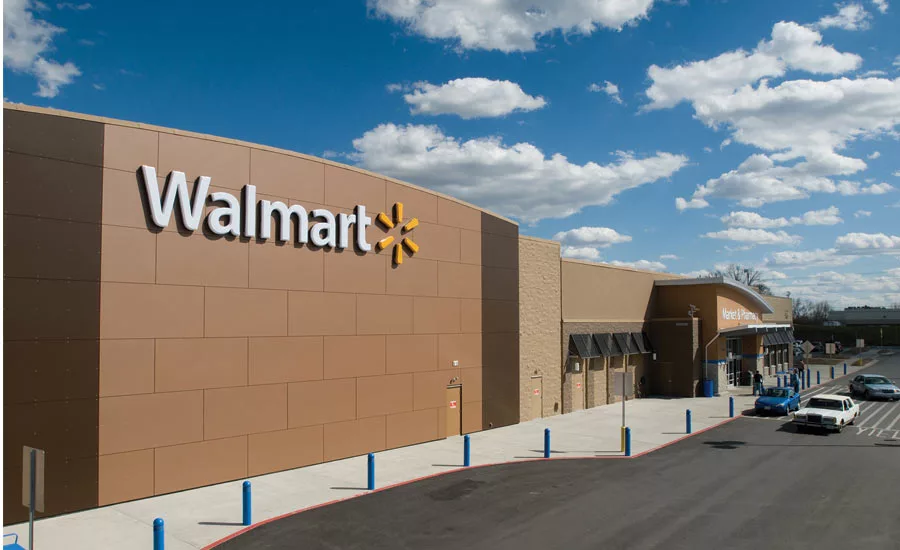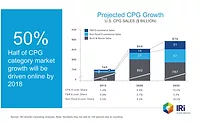Mass merchandisers decrease footprint, expand online presence
Walmart reaches milestone in grocery deliver and grocery pickup

When looking for low prices on consumables, consumers typically had flocked to supercenters and warehouse clubs, which have experienced positive year-on-year growth since 2012, reports Chicago-based Mintel in its December 2017 “Mass Merchandisers – US” report. This trend looks likely to continue as the report projected 2017 sales at $567.7 billion, an increase of 3.1 percent from the prior year and similar growth is forecasted through 2022.
However, as more consumers embrace eCommerce, the mass merchandiser channel is seeing its customers siphoned away from brick-and-mortar locations. “Mass merchandisers revenue has declined over the past year due to rising competition from online platforms,” explains Claire O’Connor, lead industry research analyst for Los Angeles-based IBISWorld. “Previously, mass merchandisers were seen as a place where individuals shopped for the lowest prices, often purchasing in bulk.
“However, now online retailers are offering even lower prices due to lower overhead costs, as well as a more convenient shopping experience for consumers,” she continues. “Due to the intense priced-based competition, profit margins have also diminished for mass merchandisers.”
Although mass merchandisers used to be known as the “unquestioned low price leader” in the grocery business, that position has been lost as supercenters, and increasingly, dollar stores and limited-assortment stores expand across the country, according to Jon Hauptman, senior director of analytics at Inmar, Winston-Salem, N.C.
In 2017, mass merchandiser stores numbered 2,483, a 10.5 percent decrease compared with 2016, according to Inmar Analytics’ 2018 “Future of Food Retailing” report. During this timeframe, dollar share grew 2.4 percent and the channel generated $41.9 billion in sales, a decrease of 1.5 percent. On the other hand, dollar stores had 32,169 stores, a 2.9 percent increase in dollar share, and annual sales of $35.9 billion, a 6.6 percent increase during the same time period, the report states.
“Supercenters continue to grow dollar sales (plus 3.5 percent versus a year ago),” Hauptman says. “However, on a relative dollar basis, dollar stores are leading the non-traditional segment growth with a nearly 7 percent dollar sales increase over the past year.
“Mass merchants used to rely on low consumables prices to help bring shoppers to the store where they’d purchase high margin non-consumables,” he continues. “However, consumables prices are just as low, if not lower, in dollar stores and limited-assortment stores, so another of the drivers of frequent mass merchant visits has been neutralized.”
Reshaping the competitive landscape
Market analysts note that several factors are impacting the mass merchandiser channel, including competition among channels, urbanization and the aforementioned growth of eCommerce. These factors are causing mass merchandisers such as Target and ShopKo to rethink their big box model, experts note.
In its March “Variety Stores in the US” report, Chicago-based Euromonitor International explains how the rapid growth of click-and-collect and eCommerce for home delivery has left larger stores with a surplus sales area.
“At the same time, these larger format stores have struggled to expand in more densely populated and growing areas. In response, mass merchandisers have innovated with smaller footprint variety stores,” the report states. “Whilst Target’s hypermarket count has declined, for instance, the retailers now operate nearly 30 stores that are less than 4,500 square meters and plan to significantly grow this figure. ShopKo Stores has also grown its Shopko Hometown variety stores concept to better reach smaller rural towns. This format now significantly outnumbers its larger Shopko mass merchandiser stores.”
The low-cost, high-value products offered by mass merchandisers typically allows the channel to perform well regardless of the macroeconomic climate, notes IBISWorld’s December 2017 “Warehouse Clubs & Supercenters in the US” report.
From 2012-2017, revenue exceeded $457 billion with a growth rate of 0.8 percent and a profit of $19.6 billion, according to an IBISWorld infographic. At 40.8 percent, food and beverages are No. 1 in products offered, followed by home and appliances (25.7 percent); health, beauty and wellness (17.6 percent); and fuel and other (9.9 percent).
“Growth has been slow over the period, as oil prices sharply declined, forcing operators to charge less for fuel at their gas stations,” the IBISWorld report states. “… Over the five years to 2022, revenue is projected to increase at an annualized rate of 0.3 percent to $464.8 billion. Increasing online competition, however, will pose a threat to the industry, as operators like Amazon increase their customer base.”
Expanding delivery systems
To stay in lockstep with eCommerce, some mass merchandisers have rolled out delivery systems, especially in large cities like New York and Los Angeles, where consumers can shop online and pick goods out as if they were in-store, IBISWorld’s O’Connor says.
“The aim is to decrease physical foot traffic in store, which enables mass merchandisers to rent a small space,” O’Connor explains. “Furthermore, mass merchandisers are expanding their own online channels to reach areas they may not have a physical presence in.”
Bentonville, Ark.-based Walmart Stores Inc. continues to dominate the mass merchandiser channel, comprising 71.7 percent of the market share, while Issaquah, Wash.-based Costco Wholesale Corp. holds 18.8 percent market share, the IBISWorld report states.
Earlier this year, Walmart announced that with the addition of Akron, Ohio, it had reached its 50th grocery delivery metro area and 2,000th grocery pickup location.
Ninety percent of Americans live within 10 miles of a Walmart store, and the company serves more than 140 million customers a week, it said in a statement.
“On Sept. 20, 2018, we’ll officially begin receiving orders at our 2,000th grocery pickup location in Fayetteville, Ark.,” the company said in a statement. “We’re growing fast — in fact, at the end of this fiscal year, we will have 2,140 access points in 430 markets, covering 69 percent of all households in the U.S.”
Inmar’s Hauptman points out that urbanization is causing all formats to look at new, dense formats that can satisfy millennials as they stream back to urban areas.
“Most [millennials] are still experimenting with smaller boxes, often on two or three levels, providing shoppers with the ‘right’ assortment of food and non-food needs,” he says. “The primary focus to-date has been somewhat upmarket, but there is still an opportunity for solid middle-market retail solutions to successfully and profitably serve urban shoppers.”
Mintel’s “Mass Merchandisers” report forecasts that by 2022, mass merchandiser sales will increase 2.3 percent to $646.6 billion annually. However, IBISWorld’s “Warehouse Clubs & Supercenters in the US” report predicts less optimistic growth for the same time period: $464.8 billion at an anticipated growth rate of 0.3 percent.
IBISWorld’s O’Connor notes that eCommerce and channel competition will continue to impact the mass merchandiser channel.
“Overall, mass merchandisers are going to continue to face competition from online platforms, such as Amazon, in the future,” O’Connor says. “This is going to increase because consumers are going to continue to become more comfortable with purchasing goods online and get used to the convenience of online shopping.” BI
Looking for a reprint of this article?
From high-res PDFs to custom plaques, order your copy today!




